BY ANIL DHOLAKIA
 For the past 60 years, I have been dealing in opals from Australia to Mexico, Brazil and Honduras. My quest for new sources of Opal has dragged me halfway around the world. The lure and play of colors from the newly-discovered African Welo Opals caused me to take a recent trip to Ethiopia to see them being mined with my very own eyes.
For the past 60 years, I have been dealing in opals from Australia to Mexico, Brazil and Honduras. My quest for new sources of Opal has dragged me halfway around the world. The lure and play of colors from the newly-discovered African Welo Opals caused me to take a recent trip to Ethiopia to see them being mined with my very own eyes.
My wife and I left Atlanta for Washington DC to take the direct flight to Addis Ababa on Ethiopian Airlines. The direct flight from Washington was 18 hours with a 1 hour refueling stop in Rome. During that flight, we were like caged animals all the way. The driv e from Franklin to Atlanta had taken 3 hours and we had arrived at the required 3 hours before the flight’s departure time. Then the flight to Dulles was another 3 hours. So we traveled an entire day just to get to Washington before boarding the long overnight flight to Ethiopia. At the end of this long and tiring journey, we were met by friends at the Addis Ababa airport and taken to our hotel for a much needed night’s rest.
e from Franklin to Atlanta had taken 3 hours and we had arrived at the required 3 hours before the flight’s departure time. Then the flight to Dulles was another 3 hours. So we traveled an entire day just to get to Washington before boarding the long overnight flight to Ethiopia. At the end of this long and tiring journey, we were met by friends at the Addis Ababa airport and taken to our hotel for a much needed night’s rest.
 We departed the next day at 10 am for the Wegel Tena opal deposit in the Delanta-area of Welo Province. This 600 kilometer journey would take 2 days travelling in a late model 4-wheel Toyota Land Cruiser, so we planned to overnight in Kombolcha. After leaving the congested traffic of Addis Ababa, the first day’s travel was very slow as the roads alternated between paved roadways at 60 to 70 km and dirt strips at 5 km.
We departed the next day at 10 am for the Wegel Tena opal deposit in the Delanta-area of Welo Province. This 600 kilometer journey would take 2 days travelling in a late model 4-wheel Toyota Land Cruiser, so we planned to overnight in Kombolcha. After leaving the congested traffic of Addis Ababa, the first day’s travel was very slow as the roads alternated between paved roadways at 60 to 70 km and dirt strips at 5 km. 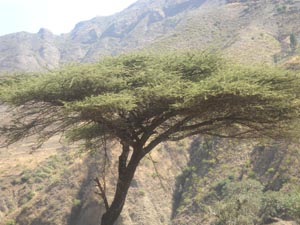 After passing several mountain passes and around the Danakil Depression, the weather became very hot and we could see desert conditions with gum and acacia trees scattered on dry hill tops and lots of camels, cows and other animal traffic. We reached Kombolcha around 6 pm and st
After passing several mountain passes and around the Danakil Depression, the weather became very hot and we could see desert conditions with gum and acacia trees scattered on dry hill tops and lots of camels, cows and other animal traffic. We reached Kombolcha around 6 pm and st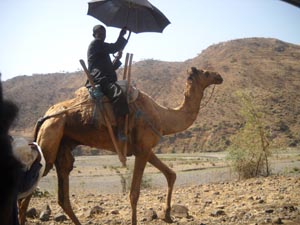 ayed overnight in a hotel that was surprisingly comfortable in spite of offering only bare essentials.
ayed overnight in a hotel that was surprisingly comfortable in spite of offering only bare essentials.
 By 8 am the next day, we were on the road to Dessie which is located in Welo Province on the the paved Addis Ababa – Asmara highway. Dessie has a large population for the area and many amenities including a Wollo University campus. From there, the road to Delanta was very rough with many switchbacks as we climbed one mountain range after another – finally reaching our destination around 1 pm.
By 8 am the next day, we were on the road to Dessie which is located in Welo Province on the the paved Addis Ababa – Asmara highway. Dessie has a large population for the area and many amenities including a Wollo University campus. From there, the road to Delanta was very rough with many switchbacks as we climbed one mountain range after another – finally reaching our destination around 1 pm.
 Delanta is a typical African village that is the center of activity for the local miners who are digging in the area and those who have the right to dig. Only people who belong to the Opal Association have the right to sell the goods. And buyers must have an export license from the Ethiopian Ministry of Mines. The average person from Ethiopia cannot handle the opals because the rules are very strict and the local people are very vigilant.
Delanta is a typical African village that is the center of activity for the local miners who are digging in the area and those who have the right to dig. Only people who belong to the Opal Association have the right to sell the goods. And buyers must have an export license from the Ethiopian Ministry of Mines. The average person from Ethiopia cannot handle the opals because the rules are very strict and the local people are very vigilant.
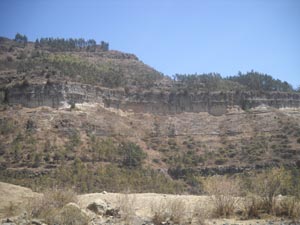 Located at a height of 3000 meters (over 10,000 feet) on top of a plateau, Delanta is above mosquito level and feels comfortable and cool. The fantastic vistas in every direction are breathtaking. But there are no facilities for Westerners to stay over, although there is a “motel” of sorts that offers small rooms at $1 per day. But no bathroom or toilet facilities in the village at all. Even though I have stayed in primitive villages in India during early school days, the absence of toilets was something of a shock.
Located at a height of 3000 meters (over 10,000 feet) on top of a plateau, Delanta is above mosquito level and feels comfortable and cool. The fantastic vistas in every direction are breathtaking. But there are no facilities for Westerners to stay over, although there is a “motel” of sorts that offers small rooms at $1 per day. But no bathroom or toilet facilities in the village at all. Even though I have stayed in primitive villages in India during early school days, the absence of toilets was something of a shock.
 We spent the afternoon taking pictures and looking at production areas. The opal mining is done with a pick and chisel and production is sporadic and slow. Some people had 200 grams for sale. Others had 500 grams. But we made sure not to handle merchandise ourselves. And ended the day returning to Kombolcha to overnight before heading on to Addis to conduct the business of buying, grading and selecting.
We spent the afternoon taking pictures and looking at production areas. The opal mining is done with a pick and chisel and production is sporadic and slow. Some people had 200 grams for sale. Others had 500 grams. But we made sure not to handle merchandise ourselves. And ended the day returning to Kombolcha to overnight before heading on to Addis to conduct the business of buying, grading and selecting.
After completing our opal buying business, we went on to take a cultural expedition to the source of the Nile known as Bahir Dar. It sits on top of high ground surrounded by the 5000 killometer Lake Tana. The area is populated with old monasteries dating back 3000 years or more that are surrounded by a simple way of life. These great and ancient structures in wood and bamboo with their amazing collections of paintings were astounding.
completing our opal buying business, we went on to take a cultural expedition to the source of the Nile known as Bahir Dar. It sits on top of high ground surrounded by the 5000 killometer Lake Tana. The area is populated with old monasteries dating back 3000 years or more that are surrounded by a simple way of life. These great and ancient structures in wood and bamboo with their amazing collections of paintings were astounding.
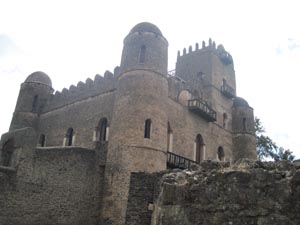 The next stop was Gondar – which was once the old imperial capital and capital of the historic Begemder Province. There were a lot of European, Japanese and Chinese tourists, but very few Americans. We stayed in 3 and 4 star hotels, but there were power shortages almost every night. It was a great sight to see the famous castles which were used as headquarters during the brief Italian occupation and the public bathhouse of the kings.
The next stop was Gondar – which was once the old imperial capital and capital of the historic Begemder Province. There were a lot of European, Japanese and Chinese tourists, but very few Americans. We stayed in 3 and 4 star hotels, but there were power shortages almost every night. It was a great sight to see the famous castles which were used as headquarters during the brief Italian occupation and the public bathhouse of the kings.
After Gondar, we traveled on to Axum – home to the Queen of Sheba. The giant carved obelisks from the Axumite Empire period were inspiring. Carved from single pieces of granite, these monumental sculptures make one appreciate what Faith has helped people do. 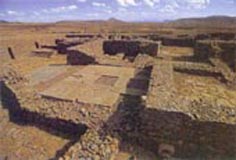 The Palace of the Queen of Sheba was in ruble. But we had a wonderful archeologist guide who brought the area alive with vivid descriptions. The Queen of Sheba introduced Christianity to Ethiopia 3000 years ago; and the imperial family of Ethiopia claims its origin directly from the offspring of the Queen of Sheba by King Solomon. This area has always been independent except for a brief occupation of 5 years by Italian colonizing efforts, but in World War II, the region was liberated from a foreign yoke.
The Palace of the Queen of Sheba was in ruble. But we had a wonderful archeologist guide who brought the area alive with vivid descriptions. The Queen of Sheba introduced Christianity to Ethiopia 3000 years ago; and the imperial family of Ethiopia claims its origin directly from the offspring of the Queen of Sheba by King Solomon. This area has always been independent except for a brief occupation of 5 years by Italian colonizing efforts, but in World War II, the region was liberated from a foreign yoke.
The cheerful smiling children we met made our trip joyous. Even in little towns and villages, it was refreshing to see kids going to school in uniforms instead of tattered begging children along the roadside that one so often encounters in certain countries. The Ethiopian children would only accept writing pens or ball point pens because they could be used for school work.
My observation about Ethiopia is that it is a pleasant nation whose people are gentle and honest. It is very crime free. It has been independent for the past 3000 years except a 5 year occupation by Italy during World War II in Mussolini’s time. The country is 80% Eastern Orthodox Christian and 20% Muslim and others. The remarkable quality of harmony among the people attests to their long history of religious devotion.

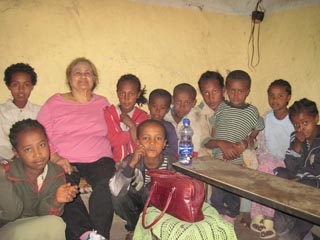
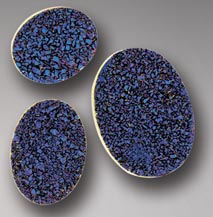
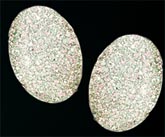

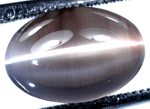


You must be logged in to post a comment.